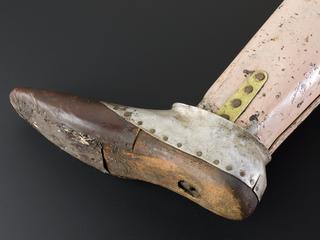

Articulated artificial right arm, iron, European, early 16th century
Attached to the body via hinged metal and leather straps this iron arm still allowed a certain range of movements. The hand is fused facing inwards, but the wrist joint can move vertically – as if to shake someone’s hand. A hollow metal globe acts as a substitute elbow joint. This may have been controlled by springs and catches, which are now missing.
Surgical amputations are referred to by Hippocrates. They were for many years a main function of the surgeon. This artificial arm dates from the 1500s. Most limbs were amputated in this era due to war injuries or accidents. French military surgeon Ambroise Paré (1510-90) gained experience as a private surgeon to generals in the French Army. He produced books on surgery in which he described new operations and treatments. These writings describe artificial substitutes he devised to replace amputated limbs. Some were simple. Others were elaborate highly-mechanised devices that simulated the natural movement and function of the limb.
Details
- Category:
- Orthopaedics
- Collection:
- Sir Henry Wellcome's Museum Collection
- Object Number:
- A121470
- Materials:
- iron
- Measurements:
-
overall: 90 mm x 670 mm 95 mm, .93kg
- type:
- artificial arm
- credit:
- Hamonic Collection




